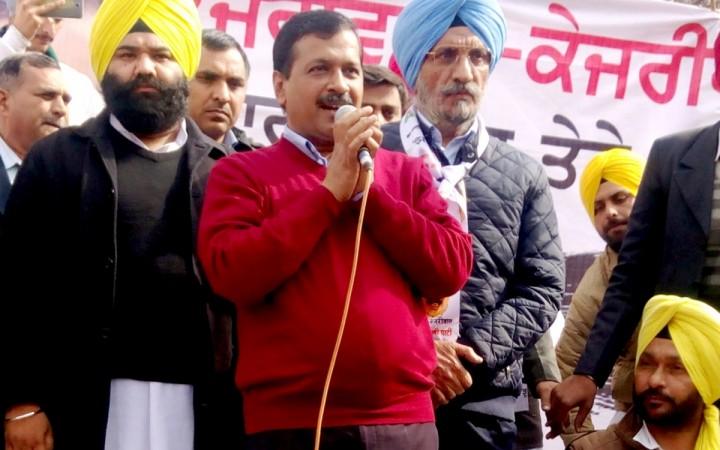
The Aam Aadmi Party (AAP) had really pinned its hopes on Punjab to clinch its second state in the Assembly election this year. It didn't succeed but nevertheless put up a fight in the state's triangular affair and ended up with 20 seats on its own. But instead of taking the positives and introspecting on the reasons for the failure to win power, the party's chief and the Chief Minister of Delhi, Arvind Kejriwal brought in allegations that it was the tampering in the electronic voting machines (EVMs) that had adversely affected the AAP's chances in the northern state.
Herein lies the AAP's problem.
Kejriwal said in a press conference on Wednesday (March 15) that 20-30 percent of AAP's vote-share got transferred to the SAD-BJP combine and that's how the Congress won the election. The AAP got a decent 24 percent vote-share in this election, just one percent less than the SAD, but yet received five seats more than the latter (15).
In the 2014 Lok Sabha election, the AAP had received 24.5 percent of the vote-share, which was the third highest, after the Congress' 33.2 percent and SAD's 26.4 percent. Yet, the AAP got four seats, the same as the SAD and one more than the Congress. In the Delhi elections of 2013 and 2015, respectively, the AAP's vote-shares were 29.7 and 54.5 percent, respectively, while its seat tallies were 28 and 67, respectively. The BJP, on the other hand, won 31 seats in the 2013 poll (33.3 percent) and a mere in four in 2015 (32.3 percent).
Hence, instead of making an already complicated relationship between seats and vote-shares more puzzling, why wasn't Kejriwal thinking about the key issues that undid his party in the latest elections in Punjab?
AAP's problem is not faulty EVMs but its own politics
The AAP's problem does not lie in the EVMs as Kejriwal is trying to make everyone believe. The issue lies with the party's lack of imagination to chart a way forward. The AAP's birth took amid chaos and there is no definite ideological grounding for the party, even though many had thought it was a platform for the anti-corruption crusaders.
The party ran its opening round too fast, hoping to derail the big parties to emerge as the front-runner but it was exposed in the Lok Sabha election where it could win just four seats. Even before that, the AAP took on its own government after leading a minority government in Delhi for just 49 days.
The AAP has always been desperate
The AAP is desperate to defeat Prime Minister Narendra Modi's BJP and its allies in every election. The massive victory in the 2015 election made it believe that it can reproduce the result at any place and time. But Kejriwal and co. need to have a reality check before harbouring big ambitions. Being a new party, the AAP needs to understand that its growth has taken a normal course. It won 28 seats in its maiden Delhi election in 2013, which was by no means a bad feat.
In 2014, Prashant Bhushan had made remarks showing AAP's 'soft side' for Maoists
But the party was looking for more. In early 2014, the year the Lok Sabha election was held, former AAP leader Prashant Bhushan had made controversial remarks about holding referenda on the deployment of army in Jammu & Kashmir and also forces in the red corridor. Many had seen it as a deliberate strategy by the AAP leadership to appease the extremist forces though Kejriwal himself had later resorted to a damage-control exercise. But the same Kejriwal's infmaous "Yes, I am an anarchist" statement made during his first stint as the CM also made it clear that the AAP has a strong conviction in sensationalism.
In Punjab, too, the AAP was accused of hobnobbing with Khalistani sentiments
Similarly, during the Punjab election this year, the AAP was accused of cozying up to the Khalistanis by both the BJP and Congress. The AAP refuted the allegations but could never justify its defence. When the explosion took place at Maur in January, the confidence of the voters in a state which has witnessed decades of unrest was shaken and the AAP, which was looking as a favourite to capitalise on the anti-incumbency mood against the SAD-BJP, lost the plot to the Congress.
Hence, no matter how much Kejriwal blames the EVMs for his party's failure to transform the mood into reality, one cannot deny that it was his party's lack of clear electoral strategy which ruined the AAP's prospects. The party never managed to find a local face and the breakdown of talks with Navjot Singh Sidhu did not help it. It remained too dependent on the central leadership and the playing down of the departure of Sucha Singh Chhotepur, a prominent leader, from its ranks, also hit it badly. The negative image of Bhagwant Mann, the party's MP who contested the election and lost, also did not please certain sections. The lack of influence in the Doaba and Majha region also didn't help the AAP despite it doing good in the Malwa region.
AAP could well be seen joining the disruptive politics of Hardik Patel during Gujarat election
The AAP's next desperation could be seen in Gujarat as it has decided to challenge Modi in his own den during this year's Assembly election. The party's strategy could remain confined to hobnobbing with Hardik Patel and his followers. But will that be enough to beat the saffron camp which is looking too powerful after the landslide victories in UP and Uttarakhand?

















